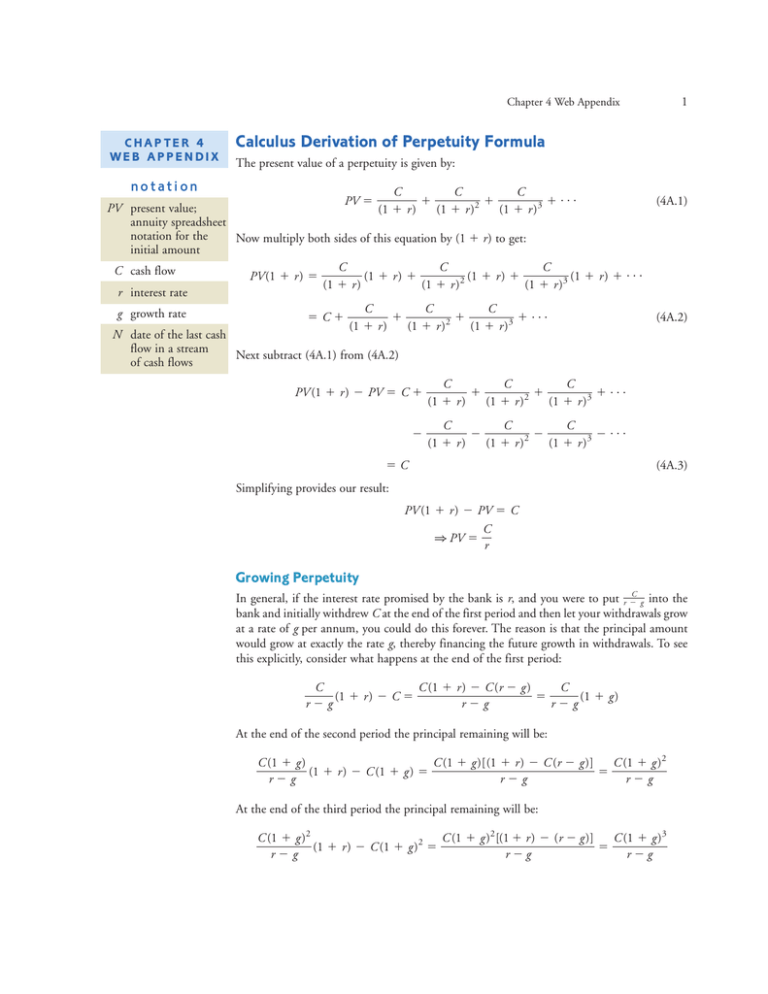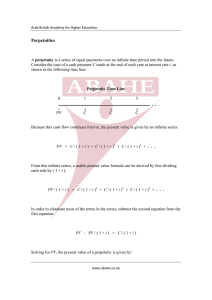Perpetuity Formula Derivation: Calculus Approach
advertisement

1 Chapter 4 Web Appendix CHAPTER 4 WEB APPENDIX Calculus Derivation of Perpetuity Formula The present value of a perpetuity is given by: notation C C C PV 5 1 1 1c (4A.1) PV present value; (1 1 r ) (1 1 r )2 (1 1 r )3 annuity spreadsheet notation for the Now multiply both sides of this equation by (1 1 r) to get: initial amount C C C C cash flow PV(1 1 r ) 5 (1 1 r ) 1 (1 1 r ) 1 (1 1 r ) 1 c (1 1 r ) (1 1 r )2 (1 1 r )3 r interest rate C C C g growth rate 5C1 1 1c (4A.2) 1 (1 1 r ) (1 1 r )2 (1 1 r )3 N date of the last cash flow in a stream Next subtract (4A.1) from (4A.2) of cash flows PV (1 1 r ) 2 PV 5 C 1 C C C 1 1 1c (1 1 r ) (1 1 r )2 (1 1 r )3 2 C C C 2 2c 2 2 (1 1 r ) (1 1 r ) (1 1 r )3 5C (4A.3) Simplifying provides our result: PV (1 1 r ) 2 PV 5 C C 1 PV 5 r Growing Perpetuity In general, if the interest rate promised by the bank is r, and you were to put r 2C g into the bank and initially withdrew C at the end of the first period and then let your withdrawals grow at a rate of g per annum, you could do this forever. The reason is that the principal amount would grow at exactly the rate g, thereby financing the future growth in withdrawals. To see this explicitly, consider what happens at the end of the first period: C C (1 1 r ) 2 C (r 2 g ) C (1 1 r ) 2 C 5 5 (1 1 g ) r2g r2g r2g At the end of the second period the principal remaining will be: C (1 1 g ) C (1 1 g )[(1 1 r ) 2 C (r 2 g )] C (1 1 g )2 (1 1 r ) 2 C (1 1 g ) 5 5 r2g r2g r2g At the end of the third period the principal remaining will be: C (1 1 g )2 C (1 1 g )2 [(1 1 r ) 2 (r 2 g )] C (1 1 g )3 (1 1 r ) 2 C (1 1 g )2 5 5 r2g r 2g r 2g 2 Chapter 4 Real Options Clearly, at the end of N periods the remaining principal would have grown to C (1 1 g )N r2g which is exactly the correct growth rate to finance the required withdrawal of C (1 1 g )N at the end of the next period (N 1 1): C (1 1 g )N [(1 1 r ) 2 (r 2 g )] C (1 1 g )N C (1 1 g )N11 (1 1 r ) 2 C (1 1 g )N 5 5 r2g r2g r2g So the law of one price demands that if the interest rate is r, a growing perpetuity that pays C, growing at rate g , r forever, must have a present value of PV 5 C (1 1 g ) C (1 1 g )2 c C C 1 5 2 1 3 1 r 2 g (1 1 r ) (1 1 r ) (1 1 r ) (4A.4) Another Derivation of the Growing Perpetuity Formula The growing perpetuity formula can also be derived by writing a growing perpetuity as a regular perpetuity and then using the formula for the present value of a perpetuity. We first need the following definition: 1 11g ; 11R 11r so R 5 11r 21 11g (4A.5) The next step is to substitute this expression into the formula for the present value of a growing stream of cash flows: C (1 1 g )n21 (1 1 r )n n51 ` PV 5 a 5 ` C C (1 1 g )n21 1 a 1 1 r n52 (1 1 r )n 5 ` 1 C C (1 1 g )n 1 a (1 1 r )n 11r 1 1 r n51 5 ` 1 C C 1 a 11r 1 1 r n51 (1 1 R )n (4A.6) Now the summation in the second term is the present value of a regular perpetuity with interest rate R and payment C. Applying the formula for present value of a regular perpetuity we get: PV 5 ` C C 1 C 1 C 5 1 1 a b a 11r 1 1 r n51 (1 1 R )n 11r 11r R (4A.7) 3 Chapter 4 Web Appendix Now we substitute for R using (4A.5) and simplify: C C 1 PV 5 1 °11r ¢ 11r 11r 21 11g 5 11g C a1 1 b r 2g 11r 5 r2g111g C a b r 2g 11r 5 C r2g (4A.8) Present Value of a Growing Annuity As before, we will create the growing annuity out of two growing perpetuities. The first growing perpetuity (in red on the timeline) begins today (which means that the first payment occurs in period 1) and the second perpetuity (in blue on the timeline) begins in period N (which means the first payment on this perpetuity occurs in period N 1 1). Both these perpetuities are shown on the following timeline: 0 1 2 Nⴙ1 N Nⴙ2 ... C C (1 ⫹ g ) C (1 ⫹ g )N ⫺1 C (1 ⫹ g )N C (1 ⫹ g )N difference: C C (1 ⫹ g ) . . . C (1 ⫹ g )N ⫺1 0 C (1 ⫹ g )N ⫹1 ... ... C (1 ⫹ g )N ⫹1 . . . 0 ... Both perpetuities grow at rate g, but note that the first cash flow of the second perpetuity is C (1 1 g )N . The timeline also shows the difference between the cash flows of these two perpetuities—it is precisely the N-period growing annuity we are trying to value. By the Law of One Price, the present value of an N-period growing annuity must be the difference between the present values of the two growing perpetuities. So to get the value of the annuity we simply subtract the present value of the two perpetuities. The present value of the first growing perpetuity (the one that begins today) is r 2C g . To value the second perpetuity we first pretend that we are currently in period N. Recall that the first payment Nis C (1 1 g )N , so applying the formula we get the present value in C (1 1 g ) period N to be r 2 g . We then use the second rule of time travel to find the value today. That is, discounting N-periods we get: C (1 1 g )N r2g (1 1 r ) N 5 C 11g N a b r2g 11r (4A.9) 4 Chapter 4 Real Options By the Law of One Price, the present value of the annuity is given by the difference in the values of these two perpetuities: PV 5 PV of a growing perpetuity that begins today 2 PV of a growing perpetuity that begins in period N 5 C C 11g N b 2 a r2g r2g 11r 5 11g N C b b a1 2 a r2g 11r (4A.10)



